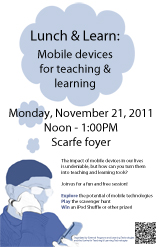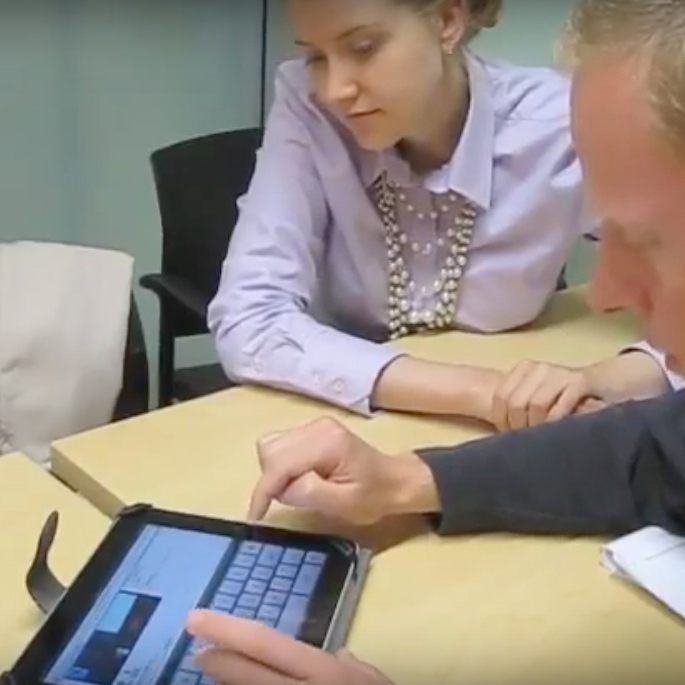Overview
Mobile devices, although widespread, were still underused for educational purposes. The project explored the potential to improve the learning experience by using mobile devices to increase student engagement. The outcomes of the project could have been used to supplement an existing online course, as well as be applied to learning environments where ownership of mobile devices is higher than ownership of internet-connected computers. Giving everyone access to education and opportunities to attain credentials was our top priority.
This project aimed to increase student participation in any online course by allowing students to access the material in the way that was convenient and best for their learning. It did not suggest to develop a new course, but to offer a potential for improvement of any online learning experience.
Goals
The goals of this project were to:
- Investigate how mobile technologies influenced the ways students participated and interacted in formal and informal learning environments, as well as how mobile devices could be used as a tool to enhance the learning experience. This included a literature review and an environmental scan;
- Apply the best pedagogical practices to identified courses and other learning opportunities with documented student feedback; and
- Produce professional learning materials containing best practices and procedural manual, as well as offer practical workshops.
in order to reach
- Those who were disadvantaged by insufficient access to high-speed internet, such as Aboriginal learners; and
- Those whose nature of professional engagement was suited more towards mobile technology than office-based environments, such as emergency personnel and police officers.
Deliverables
The final products of the project was a set of templates, accompanied by manuals and practical workshops, which would help educational institutions move towards utilizing devices that were already in everyone’s pocket. This was especially important in rural and remote areas where internet connection was still a challenge. The open education resources (uploaded in BCcampus repository SOL*R) were:
- Literature review
- Environmental scan
- Instructional design solutions: case studies (e.g. assignments, activities and content samples) that allowed for increased student participation by using mobile devices;
- Online (archived) and face-to-face (slides and handouts) workshops demonstrating how to integrate mobile device into the learning environment; and
- Text and video based documentation on the process and results.
Literature Review
Using Mobile Devices as Learning Resources for Alternative Models of Teaching and Learning: Literature Review by Jenny Arntzen
Using Mobile Devices as Learning Resources for Alternative Models of Teaching and Learning: Bibliography by Jenny Arntzen
Mobile Technology – Case Studies – by Kirsten Starcher
Mobile Technology – Environmental Scan by Kirsten Starcher
Case Studies:
- Adele Cushing, City and Islington College – transcript interview Part 1
- Adele Cushing, City and Islington College – transcript interview Part 2
- Angela Abdou, College of the Rockies – interview (audio file), transcript
- Christopher Higgins, University of Maryland – interview (video file), transcript
- Glen Lowry, Emily Carr University – interview (video file), transcript
- Jerome Rodriguez, Justice Institute of British Columbia – interview, transcript
- Natalia Lopes, UBC – interview (video file), transcript
- Paul Cubbon, Sauder School of Business, UBC – interview, transcript
- Steve Musson, Recreation Studies, Langara – interview, transcript
Survey on the use of mobile devices conducted at UBC with Teacher Candidates and Faculty Advisors in the Teacher Education Program: Final report
Event
Lunch ‘n Learn: Mobile Devices was a one-hour event, a demonstration of the potentials of mobile technologies. The presenters were: Cindy Underhill: visual Notetaking; Joe Zerdin and Kyle Gailling: Snap’n’Know appls, Emily Renoe: ePub, Brian Wilson: Augmented Reality and Lucas Write: QR codes. (poster) The visitors had the opportunity to play the scavenger hunt using their mobile devices and win an iPod shuffle. The Scavinger hunt was organized by Brian Wilson – Zack Lee, using foursquare and SCVNGR. Support by Sharon Hu and Ian Linkletter from EPLT.
Special thanks to the Centre for Teaching, Learning & Technology (CTLT) for their support.
Project Team
Project Management
Natasha Boskic, Educational Technology Manager, EPLT
Partner
Rob Bowled, Specialist, Credentials and Applied Research, School of Health Sciences, Justice Institute of British Columbia
Collaboration
Mark R. T. Dale, University of Northern BC
Laura Cooper, College of the Rockies,
Langara College
Environmental Scan and Media Development
Kirsten Starcher
Graduate Research Assistant
Jenny Arntzen, Graduate student, UBC
Instructional Design
Sharon Hu, EPLT
User Support Specialist
Ian Linkletter, EPLT
43,500
